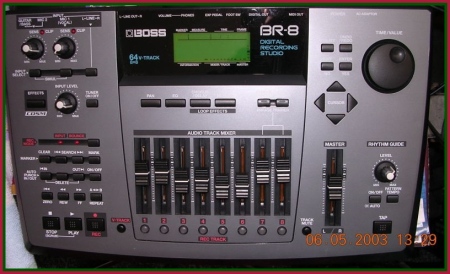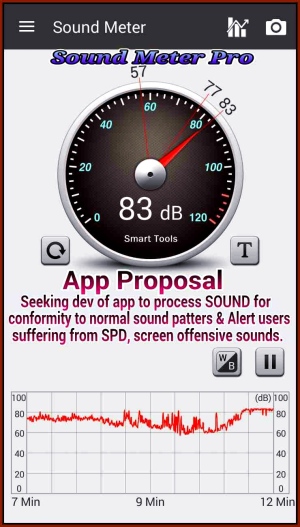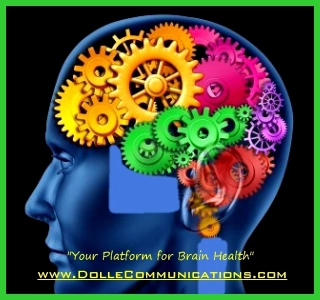
Decibel meter apps are helpful in managing the ill effects of sound exposure in brain injury, hydrocephalus, ADHD, PTSD, and related sensory processing disorders. Sound Meter is best app on Android. The Pro version is $.99. Though either is good. SPLnFFT is said to be best app on iPhone. Many are accurate enough for these purposes. Plus, what you really need, is comparative analysis of sound to medical sequela in the same app.
The science in support of monitoring sound level exposure comes amid findings that “sound” can trigger medical sequela, and result in a combative child or even adult out in public. The sequela typically ares headache, nausea, decreased cognition, irritability, and behavioral outbursts, and occurs in persons suffering from a variety of neurological injury & disorders. Light, motion, and scents are also triggers. The sensitivity, and type of trigger, does vary somewhat from person to person.
The medical condition for this is termed “sensory processing disorder” or SPD, and sometimes termed “sensory integration disorder,” and these tend to follow brain injury, neurological surgery (numerous ones including hydrocephalus and tumor), and many types of neurological disorders.

At any given time, the effected person is vulnerable to a range and type of sound triggers. Yet, this sensitivity and vulnerability often may not be known until AFTER the exposure. Often all it takes is 30 secs of problematic sound exposure to set off a sequel of SPD complaints. Then, you’re dealing with a medical problem.
Certainly the big ones like loud machinery, music, and room noise are predictable. But it is the not so loud and obvious exposures that’ll get you. And NOT knowing at any given time what your sensitivity or threshold is. And this comes from trial & experience.
I recommend downloading one of these apps and using it regularly for a couple of weeks to learn of your LOWEST threshold decibel levels – for when you’re not feeling well, and for various venues. Then, you can do things with more confidence in that you know your thresholds and can take the necessary interventions SOONER to avoid an ill spell or “melt down” in public. Today I learned too late, after being near a store playing loud overhead music. It was registering over 80 db on my Sound Meter app. I had not checked the sound level when I arrived. Once your system is triggered, it is often too late for other interventions or measures, and you’re likely going to have to leave that venue.
Unfortunately, current apps do not measure frequency distribution or sharp spikes in sound. Sound between 5000 Hz – 10,000 Hz is often problematic for individuals suffering with SPDs. The other causative elements includes sharp spikes in decibel level, and disordered sound presenting as “white noise.” If you, or a family member, suffers from sensory processing disorder, you know what I mean.
I undertook a sound sensory study in 2002 using a metronome to evaluate SPD complaint responses to various rhythmic patterns, and I was able to show that the component in sound most responsible for SPD complaints was “lack of rhythmic pattern.” My findings explain why white noise, or room noise, is so problematic. Read my full study below:
Study on Sound, Cognition and Sensory Processing

There are many treatments today that have found varying degrees of success in raising a person’s threshold to SPDs. They include: EMDR therapy, music therapy, group drumming (in which I have conducted research), bio feedback, mindfulness, basketball, meditation, occupational therapy. A variety of mild barbiturate medicines find use as well. I can’t say enough about the importance of proper rest & diet, managing stress, and drinking plenty of water. Vestibular exercises, meditation, mindfulness, and biofeedback therapies seem to help raise an affected persons sound intolerance.
New Dolle Communications Web Page on Cognitive Neuroscience

Once an exposure and SPD medical sequel has begun, your options include:
1) have the individual stay focused & “engaged” in an activity
2) insert quality ear plugs (suggest musician’s ear plugs)
3) remove the affected person from the triggering noise source
4) administer barbituate, pain or calming medication
5) force hydration preferable with water
On June 4, 2015, I published an extensive blog on basketball – which includes methods in shooting baskets, mindfulness, biofeedback & relaxation, and including drumming with basketball – which helps the brain, movement disorders, intolerance to sound, post concussion syndrome, and relieves stress.
(Dolle Blog) Sports Science vs Brain Science of Basketball

Understanding Sound Sensory Processing & your Intolerance Level
If you suffer from sound sensory processing difficulties, I suggest you try one of the available decibel meter apps. I use the Smart Tools Pro Sound Meter pictured below. It also has a built in Vibrometer to evaluate motion say on a boat or car. You need to become familiar with your sound threshold range and intolerance, and screen typical levels at places you visit. You’ll need to add further consideration if there is machinery or other problematic noise that the individual would normally not process very well. All it takes is 30 secs of a problematic sound exposure to set off a sequel of SPD complaints. Develop good rules of practice.

Call for a Sound Sensory Processing Scale & Algorithm of Measurement

The current challenge is that these apps only measure level of volume. What we need, is a sound distribution EQ scale to equate how the brain processes sound (along with volume), which would require a convening of neurologists to scientists study this relationship, and establish a new sound scale to include the difficulty of processing of sound distributions. Sound engineers already know a great deal about the distribution or EQ of sound. To establish a sound processing scale, we would only need to equate various EQ sound patterns with the level of difficulty of processing by the brain. There are already sound identification apps that can identify patterns in music and ID them by song name. Two very popular apps are Soundhound and Shazam. We could use these existing sensors and algorithms to ID sound as very unforavorable vs acceptable in terms of ability to be processed by the brain. Persons with brain injury, learning and neurological disorders, and SPD (sensory processing disorder) have a diminished capacity to process sound, which I believe pares the degree and location of deficits in the brain. So, I have proposed the development of a sound processing scale and algorithm.
This new sound processing scale would encompass:
1. decibel volume and rate of change between volume levels (i.e. spikes)
2. EQ frequency distribution of the sound
3. rhythmic distribution and synchronization of the sound (i.e. white noise)
I host a larger blog on sensory processing challenges with examples of problematic sounds of machinery, etc. Just follow the link below. I try and keep these blogs up to date as time permits. My biggest new discovery in SPD comes after a study I undertook almost two years ago with the MigraineX ear plugs used in the management of headache, but also in sound suppression. I found that insertion of the MigraineX ear plugs before, and even after a harmful sound exposure has occurred, can lessen the associated headache, irritability, cognitive, and SPD complaints by 50% or more. Yes, I said SPD. So I carry the MigraineX ear plugs with me all the time. They are particularly helpful amid noise from construction, machinery, malls, restaurants, theatre halls, and more. They sell for about $12 on Amazon and many drug stores.
Secondly, I have been undertaking new barometric pressure monitoring utilizing my Samsung phone’s built in barometric pressure sensor. The built in sensor can display sharp Short term changes in pressure that weather sites often do not display. Most newer high end smart phones have this sensor built in. But you need to download an app to get the display. For this, I use the uBarometer Pro.
(Blog) New Insights in Sound Sensory Processing Disorder
If any app developers are reading this, I’d love to collaborate with you on building an SPD intollerance sound EQ app for screening of problematic sound. I can advise scientifically and in the UI (user interface, I have a good tech bkg-see page below). I’d like to couple an app with a Melon or NeuroSky EEG headband to try and correlate changes on EEG waveform with reported SPD complaints. SEE my extensive work in hydrocephalus monitoring and DiaCeph Test app design.
ADA laws with respect to sound protection for persons with SPDs is termed “cognitive accessibility.” There is an interesting legal case between families of children with autism and Disney, regarding Disney’s cancellation of the handicap pass to circumvent affected visitors standing in long lines, thereby forcing affected children to stand in line amid commotion and noise, which is unhealthful and can trigger behavioral outburst and a number of medical sequela in SPDs.
Deadline.com: Disney sued by Families with Autism over Handicap Pass

I am advocating for a new sound processing standard to encapsulate the brain’s role in processing sound. Persons suffering neurological disorders and from SPDs have a diminshed capacity to process sensory information, sound being the most common issue.
I host a related web page on sensory processing and cognitive or intellectual disabilities at www.CognitiveAccessibility.org.
Please visit my web site and contact me accordingly. Best method of contact is email.
Stephen Dolle
Neuroscientist, mHealth Inventor & Drum Circle Facilitator
Email: contact[at]dollecommunications[dot]com
Hydrocephalus Survivor w/ 12 Shunt Revisions
DolleCommunications.com


My June 4, 2015 blog about basketball also shares some useful information on use of shooting baskets and drumming in sensory processing disorder. Here’s the DolleCommunications Blog short link:
http://wp.me/poW1N-8E
LikeLike
[…] Mobile Sound Level apps Helpful in Managing Sensory Processing Disorder […]
LikeLike
[…] Mobile Sound Level apps Helpful in Managing Sensory Processing Disorder […]
LikeLike
[…] Mobile mHealth Sound and Related Apps helpful in Hydrocephalus […]
LikeLike
[…] Mobile mHealth Sound and Related Apps helpful in Hydrocephalus […]
LikeLike
[…] Mobile Sound Level Apps helpful in Managing Sensory Processing Disorder […]
LikeLike